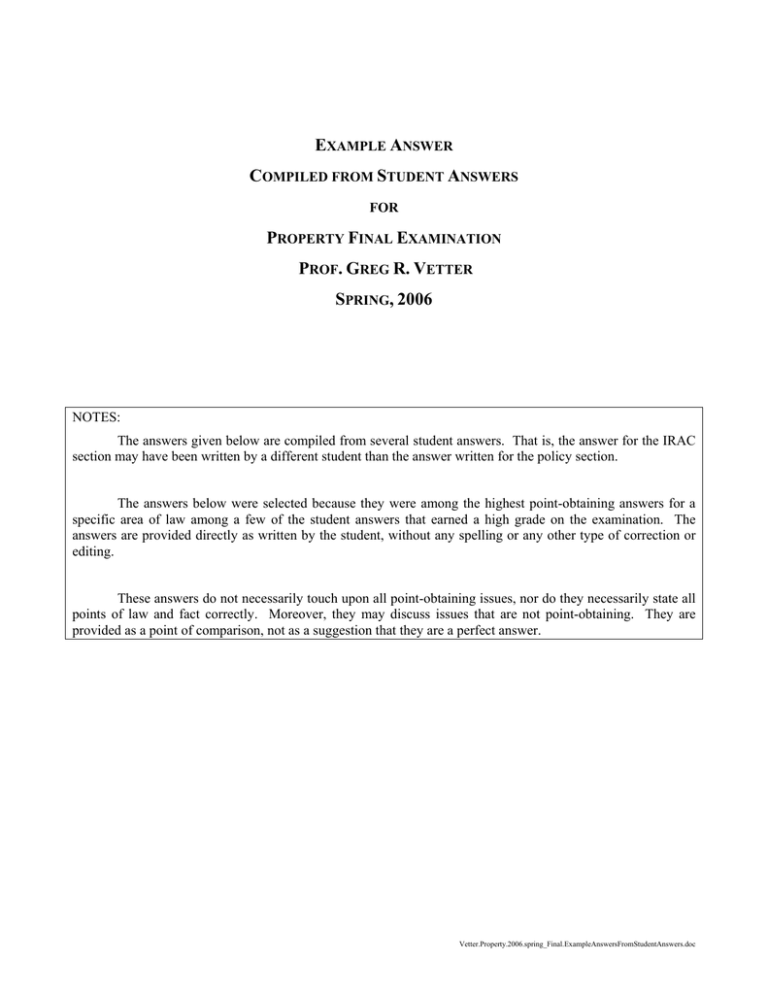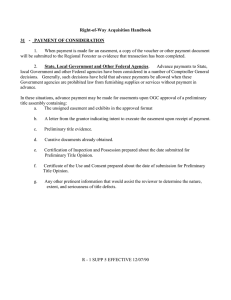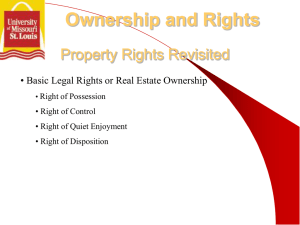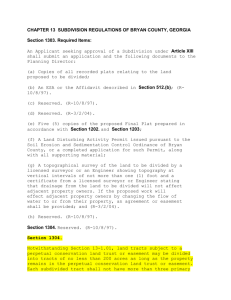E A C
advertisement

EXAMPLE ANSWER COMPILED FROM STUDENT ANSWERS FOR PROPERTY FINAL EXAMINATION PROF. GREG R. VETTER SPRING, 2006 NOTES: The answers given below are compiled from several student answers. That is, the answer for the IRAC section may have been written by a different student than the answer written for the policy section. The answers below were selected because they were among the highest point-obtaining answers for a specific area of law among a few of the student answers that earned a high grade on the examination. The answers are provided directly as written by the student, without any spelling or any other type of correction or editing. These answers do not necessarily touch upon all point-obtaining issues, nor do they necessarily state all points of law and fact correctly. Moreover, they may discuss issues that are not point-obtaining. They are provided as a point of comparison, not as a suggestion that they are a perfect answer. Vetter.Property.2006.spring_Final.ExampleAnswersFromStudentAnswers.doc PROPERTY EXAMINATION, 2006 A. EXAMPLE ANSWER COMPILED FROM STUDENT ANSWERS Doctrine-Application “IRAC” Section Brandell (B) v. Yorba & Zeb (Y&Z) The first issue is to consider the conveyance of KrostAcre (KA) in Oscar's (O's) will to identify the interests it created in KA. First, it created a possessory life estate in Alice (A). It then gave a vested remainder in term of years (for 20 years) to Betty. Finally, it created a remainder in O's heirs (Y&Z) since the will did not designate who the remainder should go to. When A died on Jan. 1, 1980, Betty's term of years estate became possessory. Therefore, Betty interest ended on December 31, 1999. On Jan. 1, 2000, KA reverted to Y&Z as a possessory estate in fee simple absolute. Therefore, Y&Z have superior right of title in KrostAcres and were entitled to lease the land to B. But, when B showed up to take possession of KA, they found it still occupied by Krager (K). The success of B's suit against Y&Z will hinge on whether the jurisdiction follows the American Rule or the English Rule. Under the American Rule, the landlord (Y&Z) must only provide legal possession of the leasehold estate. In other words, they must only put the lessee (B) in superior right of possession. They have no duty to ensure that the property is open for entry. This rule assumes that the tenant has adequate remedies against the holdover tenant, and it reduces lawsuits (instead of B suing Y&Z, then Y&Z suing K, B can sue K directly). Y&Z will argue for the American Rule, and move for dismissal since they have established superior legal right of possession (as discussed above). If the jursidiction follows the American Rule, Y&Z's motion will be granted, and B will have to pursue remedies against K directly. Under the English Rule, the landlord (Y&Z) has an implied covenant promising that the premesis will be open to entry to the lessee (B) at the time fixed by the lease (Jan. 1, 2000 in this case). If the premises are not open to entry, the lessee has a cause of action against the landlord. This rule assumes that the landlord is in a better position to ensure the property is open and is in a better position to take legal action to force off any holdover tenants. B will argue for the English Rule based on these policy grounds. If the jurisdiction follows the English Rule, B has a valid cause of action, and will likely prevail. The English Rule, ironically, is followed by the majority of the states, therefore, chances are that this jurisdiction follows the English Rule, and B probably will suceed in his claim against Y&Z. Sally (S) v. Krager (K) S inherited the possessory term of years estate from Betty upon her death on Jan. 1 1990. At that time, there were exatly 10 years left in the term of years. The key issue in S's suit against K is whether the transfer of the leasehold estate in KA from WholeWallet (WW) to K was a sublease or an assignment. An assignment is created when the grantor grants the entiritey of his leasehold estate to the grantee with no reversionary interest. A sublease is created when the grantor grants less than the entirity of his leasehold estate to the grantee, either leaving some of the land area for himself, or leaving himself a reversionary interest. 1 Vetter.Property.2006.spring_Final.ExampleAnswersFromStudentAnswers.doc PROPERTY EXAMINATION, 2006 EXAMPLE ANSWER COMPILED FROM STUDENT ANSWERS Although the transfer document used the word "sublease", this is not determinative since the modern approach is to ascertain the intent of the parties, and give effect to that. S will argue that the transfer was an assignment. Her life estate ended on Dec. 31, 1999. She could not lease to WW any more than what she owned, therefore, even though WW's lease purported to be for 15 years, it would immediately end after only 10 years. WW, therefore, really only had a 10 year interest in KA. Therefore, when WW transfered the lease to K on Jan. 1, 1995 for 5 years, they transfered the entirity of their leasehold estate to K. This means that the tranfer was an assignment, creating privity of estate between S and K, and giving K the right to sue K for the unpaid year's rent. K will counter that the transfer was a sublease. WW beleived that they had a 15 year lease, not a 10 year lease. Thus, at the time of the transfer, the intention of the parties was to sublease KA to K for 5 years, leaving a 5 year reversionary interest in WW. If the court really wants to give effect to the intention of the two parties (K and WW), it will hold that the transfer was a sublease. A sublease would not have created privity of estate between K and S, and S would not be able to sue K, except on a third-party beneficiary theory. However, in the transfer document, K made no promises to pay the rent or take on WW's responsibilities under the lease. Therefore, S probably cannot sue on a third party beneficiary theory. In conclusion, the formalistic rules of assignments and subleases indicate that the transfer was a sublease, but the modern rule of giving effect to the parties intent indicates that the transfer was as sublease. Because the court will probably follow the modern rule, and because K had no way to know that S's life estate would end in only 5 years and thus that they could be taking on an assignment rather than a sublease, the court will probably decide that the transfer was a sublease, and that S's claim must be dismissed for lack of privity. Z v. S (easement) Z will sue S for misuse of the easement beginning Jan 1, 2000 when she began using it to move large animals from Old South Road to comply with the city ordinace. The easement was created by express grant from O to DC&H in 1970. The easement is appurtenant to TUIIAcre (TUIIA) because it benefits the owner of the easement in the use of land (TUIIA). Appurtenant easements attach themselves to the land (the dominant tenement), and are transfered with the dominant estate when it is sold. Therefore, when S bought TUIIA from DC&H, she also became the owner of the easement. Therefore, she did have the right to use it. Z will argue however, that she misused the easement. Appertenant easements may not be expanded beyond the scope defined at the time of creation except for reasonable and forseeable changes in use that benefit the dominant owner and/or that occur as technology changes or improves. However, the easement owner may not begin using the easement for another adjoining tract of land, or in a manner that causes unreasonable damage to the easement. Z will argue that when Sally began using the easement for PenAcre she misused the easement. Also, when she began moving large animals, even elephants accross the easement, which was originally created for law students, she used the easement in an unforseeable and unreasonable manner. Furthermore, the use damagest the easement, and Z had to regularly repair the walkway. 2 Vetter.Property.2006.spring_Final.ExampleAnswersFromStudentAnswers.doc PROPERTY EXAMINATION, 2006 EXAMPLE ANSWER COMPILED FROM STUDENT ANSWERS S may argue that even if she is misusing the express easement, she has an easement created through other legal theories. However, a claim for an easement by prescription would probably fail because she has only been using the easement for the large animals for 5 years, less than the statutory period. She probably cannot tack to the use of the previous owner because it was for another reason. A claim for easement by estoppel also probably will fail because S did not make any large investments In TUIIA based on permission that she received from Z to use the easement in this manner. Finally, an easement by implication (either quasi-easement or strict necessity) is not created because TUIIA and BateAcre (BA) were never owned by a common owner. No matter how strict S's necessity is, without the common owner, no easement by strict neccessity is created. Therefore, Z will probably win in his claim against S for misuse of the easement. He can likely get damages for the past misuse and may get an injunction to prevent future misuse depending on how the litigation discussed below turns out. S v. Z (adverse possession of Westfield) S will claim that she has taken ownership of Westfield (WF) by adverse possession. She will claim that she has satisfied all four elements: actual and exclusive possesion (she has used WF each weekend to see pimentos, has camped there on the weekends, and no one else has used it at all), open and notorious (Z&Y had actual notice of her use, thus satisfying this element), claim of title adverse to the true owner (S knew it was not her land, but intended to make it hers. This would satisfy the adverse element under either the Maine doctrine, where the AP must have a hostile mindset, or the Connecticut doctrine, where the AP's mindset is not relevant), and finally continuous for the statutory period (S will claim she has continuously used WF for 10 years to sell pimentos). While Z may not be able to counter S's arguments for the first 3 elements, he can argue that S does not meet the last element (continuous use). THis element can only be satisfied if the land is used for the normal use that industrial land is typically used for. Since industrial land is normally used on the week days for businesses, and is not utilized on the weekends, her use does not satisfy this element. Because the final element required for AP is not satisfied, S will probably lose her claim for AP of WF. S v. Z (partition of BA) First, S will have to show that Y validly severed the joint tenancy between Y and Z. First, Y conveyed the land to himself. In most states, a person can sever a joint tenancy by conveying the land to themselves without using an intermediary device (e.g. strawman). The intermediary device is a vestige of the feudal days, and not often required these days. So, most likely, this will not be an issue. However, most jurisdictions require some form of notice to the other joint tenant for such a severance to be valid. This is to prevent a "secret" conveyance to ones self to guarantee that you will either retain full possession through the right of survivorship if you survive your joint tenant, or that you can pass your interest to your heirs if you die first (since you severed the joint tenancy). Therefore, if Y may have been required to 3 Vetter.Property.2006.spring_Final.ExampleAnswersFromStudentAnswers.doc PROPERTY EXAMINATION, 2006 EXAMPLE ANSWER COMPILED FROM STUDENT ANSWERS give actual delivery notice to Z, or at least record the conveyance to himself, giving Z constructive notice. But, even if he did not, it does not matter because the next day he conveyed his interest in BA to S before his death. A conveyance to someone else of a person's interest in a joint tenancy severs the tenancy, creating a tenancy in common. Therefore, either way, S and Z are now tenants in common in BA. Y's death the next day becomes irrelevant. Any partner in a joint tenancy can sue for partition. S is asking for partition in kind, which is what the courts prefer, so long as the land can be divided equitablly. First, S is asking for the western part of the lot, including WF. This part will probably be granted to her since she is using it for selling pimentos and camping there on the weekend. While she has made no improvements to this part of the land, it may have some intangible or "personhood" value to her since she has used it for the last 10 years. Next, S seeks the eastern part of BA, including the easement. She may not be granted the eastern part because Z has expened money to improve/repair the walkway. On the other hand, she can argue it makes sense for her to get the eastern part also because she uses the walkway to move her animals. Z can counter that now she can move her animals accross WF to reach TUIIA. Regardless, Z can recoup some of his repair expenses as part of the partition action since they were reasonable repairs. Z v. S (waste of KA) Waste occurs when a possessory owner interferes with the expectations of another concurrent or consecutive interest owner in the land. Z will claim that S affirmatively wasted the resource of the valuable grape vines on KA when she placed a huge pile of dirt on the vines, destroying them. Z had a reasonable expectation that when S's life estate ended, he would have the enjoyment of the vines when his concurrent fee simple interest became possessory. This is probably a reasonable expectation, and Z will probably win on this claim. Next, Z claims that S wasted the property by leasing to WW. This is not affirmative waste because WW did not harm the premises or take away any valuable resources that Z may use. They did improve the premises, but the old common law rule forbiding ameliorative waste (by improvement) is no longer followed. Also, S did not permissively wast KA by leasing to WW. THe land did not lay unused, but was occupied by a rent-paying tenant. Even when WW left, they subleased to K, so the land was being put to productive use. IT would be bad policy to punish a land owner putting land to productive use for waste simply because the future interest holder does not like the tenant. This waste claim will probably fail. 4 Vetter.Property.2006.spring_Final.ExampleAnswersFromStudentAnswers.doc PROPERTY EXAMINATION, 2006 EXAMPLE ANSWER COMPILED FROM STUDENT ANSWERS B. Policy The current state of the law in other jurisdictions is lisetd on Page 381 and need not be repeated. Clause One Arguments in Favor The proposal is a fixed rule that would settle the disputes over these issues. This would decreaes the transaction costs (since attorneys are transaction costs). Also, the requierment of the appraisal promotes two ends: First, it opens up the channel of communication regarding the improvement and allows people to settle, possibly finding an alternative method that is outside the legal system but more beneficial to the parties. Also, the appraisal allows for a fixed value which will decrease conflicts over whether something is an improvement or not. Arguments Against First, I had to read the provision twice to get the numbers straight. If those of us writing the policy find it confusing, then non legal practitioners will likely find it confusing. This would nullify any benefit of lowered transaction costs since the cotenants won't know about the law until a lawyer tells them about it. Also, appraisals are expensive. Although the appraisal MAY decrease transaction costs if there is a conflict, it defiatenly WILL increase transaction costs every time an improvement is made. Furthermore, an appraisal isn't the only way to determine if an improvement increased the value of the land. If the parties are going to court anyways, they might as well argue that too. Finally, this provision may be unnecessary since it opens up the communication channels to create an agreement before the improvement is made. If the parties are already in a position to agree, there is no need to apply such a strict rule. Clause Two Arguments in Favor Generally, property laws are written to be hte most economically beneficial. This provision is a welcome change from that approach, trying to promote improvements by imperfect economic practitioners that have an unquantifiable benefit both to the property and to society. The value of such improvements are unknown and therefore cotenants are not likely to agree on whether the improvement should be made, especially when there are multiple cotenants and a collective action problem. This rule also brings back a sense of personhood in property, promoting a cotenant to take a personal attatchment to the land and bring a human perspective to what is a purely fungible society. Arguments Against The biggest issue here is why should the other cotenant subsidize this behavior by the artistic cotenant? If the cotenant wants to paint a mural, he should have to pay the cost of that since he is the one primarily receiving the benefit. There is a reason that property rules are geared toward improving the economic fortunes of those who own property. Furthermore, this personal attatchment will make things more difficult when the property must be partitioned, increasing transaction costs. Finally, this sort of interest seems to violate the "interest of the whole" 5 Vetter.Property.2006.spring_Final.ExampleAnswersFromStudentAnswers.doc PROPERTY EXAMINATION, 2006 EXAMPLE ANSWER COMPILED FROM STUDENT ANSWERS rationale for the joint tenancy. The artistic cotenant has a higher interest in the painted wall than the other cotenants. Then again, joint tenancies put substantial barriers to maximizing current use of the land, execting joint tenants to just wait until the rest die. This atleast promotes efficient use even if it violates the spirit of the joint tenancy. Clause Three Arguments in Favor This clause makes sense for joint tenants (although less so for tenants in common) since the interests should be in unity. If one owner has a higher interest in the land than the other which manifests at sale, by definition there could not have been a joint tenancy. Plus, since the improver is out of pocket now, he should have received the money earlier to make up for his loss. Arguments Against This provision is based on the idea that all the issues shoudl be settled before hand and therefore there won't be any need to seperate the costs at sale. However, this is a faulty assumption. First, the owners are more likely to keep a running ledger than to pay immedately, like the ranchers in Ellickson's article. Second, this requires an upfront liability on behalf of the othe cotenants. To borrow a tax phrase, there is no realizatn event. The proper thing to do is to allow the other owners to reimburse at sale since that's when they'll actually have money in their pocket. Otherwise, the owners may not have money til then which would lead either to premature lawsuits between coowners or settlements outside the law which make the law unnecessary. Conclusion Coase would argue that this proposed statute does more harm than good. Coase proposes that, in a world of no transaction costs, the dispute between parties (or coowners) would not turn on the legal rights and liabilities. The parties should simply be allowed to negotiate for the best deal for themselves. Although this approach doesn't quite fit here since the coowners are not likely to legally negotiate every improvement (which creates the necessity for the law in the first place), the reasoning still holds. The proposed statute does not provide for an opt-out clause, which would allow those who want to work outside the system (like the Ellickson ranchers) to do so. Many of these coownership agreements are informal, and many would prefer not to bring lawyers into the picture. First, I think that the choice should be between clear rules: complete reimbursement based on ownership interest or no reimbursement and the reimbursement is made at sale if the improvement increased the value of the land. Any solution in the middle is confusing and doesn't give a clear guide to the coowners who are making the improvements. Given those two choices, I would opt for a no reimbursement system unless an agreement is in place. This promotes the idea that improvers shoul get consent from the other owners and otherwise should take the risk/reward of the improvement increasing the value of the property. 6 Vetter.Property.2006.spring_Final.ExampleAnswersFromStudentAnswers.doc






